
It is 22:18 on Thursday 24 September 1959. At Bordeaux-Mérignac airport, a Douglas DC-7C propeller-driven aircraft (the very one pictured above, registered F-BIAP) readies for takeoff on the second leg of TAI Flight 307, the regular connection operated by the French airline Transports Aériens Intercontinentaux (TAI) between Paris and Abidjan, the capital of Ivory Coast, via Bordeaux and Bamako in Mali.
The Mérignac stopover has lasted two hours and everybody on board – nine crewmembers and 56 passengers – is in good spirits as the plane levels up on runway 23, the airport’s main takeoff and landing strip. There is moderate wind and a light drizzle, but visibility is fair. Chief pilot Maurice Verges and copilot Jean Bouchot are given the all-clear by air traffic control and at 22:23 the DC-7 sets off on its eight-hour flight to Bamako.
After routinely leaving the ground the aircraft ascends to an altitude of 30 metres but fails to climb any further and even starts to drop. At a spot situated just over 1,000 metres from the tip of the runway, some 2,950 metres on from its initial departure point, the plane clips some of the tall trees (22.5 metres high) that form the dense “Landes de Boulac” pine forest on the territory of the village of Saint-Jean-d’Illac. Knocked off course, the right wing becomes damaged and the plane falls to the ground, the fuselage breaks up into pieces and wreckage is instantly strewn over a distance of several hundred metres. Multiple explosions occur resulting in a number of fires which quickly spread to the trees, although the damp ground prevents the fire from extending beyond the crash site.
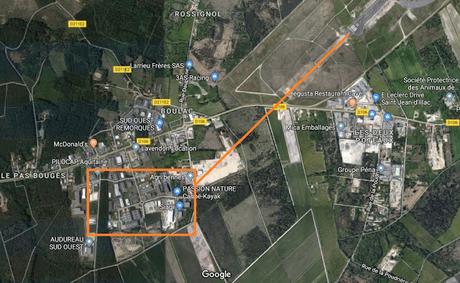
Top right: the tip of Mérignac airport runway 23 (or 05 if approaching in the other direction), and bottom left, the approximate crash site, much of which now comprises small industrial units. Wreckage was spread over several hundred metres, mainly to the area that lay to the right of the aircraft's trajectory (orange line). Map/satellite data: Google.
In the immediate aftermath, rescue efforts are hampered by darkness and the sheer inaccessibility of the area; the rudimentary road structure means emergency vehicles are unable to approach any closer than 800 metres to the impact site. Miraculously, twelve passengers are found to have survived, having been thrown from the aircraft. They are rushed to hospital in Bordeaux, where one will later die. The crash of TAI Flight 307 therefore ultimately results in the death of 54 people, including all crewmembers.
A picture of the crash site, with wreckage visible in the distance. Picture credited to International Magazine Service for Paris-Match/Marie-Claire, source: Amazon.
So, what happened? In the report into the investigation released by France’s Bureau Enquêtes-Accidents de l’Inspection générale de l’aviation civile, sécurité et navigation aériennes (nowadays simply referred to as the BEA, Bureau d'Enquêtes et d'Analyses), three key factors were earmarked. Firstly, the two-year-old aircraft’s lights were not in operation. This may not immediately strike you as being an issue, but it is when combined with the second factor, namely that there were also no lights on the ground in that area to enable the pilots to have a sense of how low they were. Which takes us on to the third and most critical factor of all: the pilots were not paying attention to the altimeter and therefore had absolutely no knowledge of how low they were flying.When replicating the same conditions during a reconstruction flight in Brétigny, near Paris, the Bureau established that an increase in speed during a very short critical phase (lasting around 10 seconds beginning 40 seconds after full throttle) can considerably reduce the aircraft’s rate of climb or even cause a loss of altitude, and that with a lack of visual references the pilot “may follow a line of flight that will bring the aircraft back near the ground if, during this period, optimum climbing speed is not maintained and the altimeter is not carefully watched”.
Returning to the scene of the crash today, much of the area is occupied by small-scale industrial units, although immediately beyond that a wide expanse of farming land can be found, along with clusters of dense pine forests, much like the area where TAI Flight 307 crashed. Even now, it is easy to imagine how isolated and out-of-reach the crash site must have been in 1959, despite being so near to what was already a major airport for its time. One section of the woods where I go wandering appears to have been transformed into a makeshift rubbish dump, which doesn’t seem to be the most dignified of destinies for this historic site.

The scene in the area today, with a dense pine forest still thriving to the right.
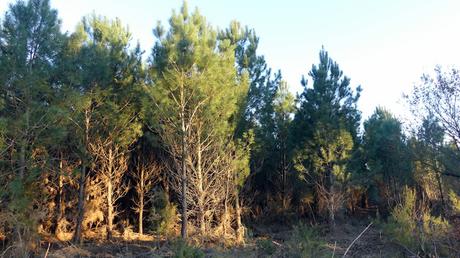
A closer look at part of the forest of apparently young pines.
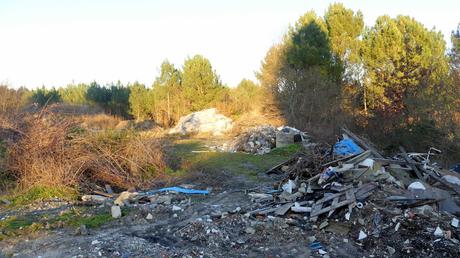
Not the most dignified of memorials...
As I’d expected, unless I missed something there is no information panel or memorial of any kind to the tragic events of September 1959 on site, but to the southern flank of Chartreuse cemetery in central Bordeaux a lasting tribute remains. For that is where you will find the final resting place of copilot Jean Bouchot (aged 32), mechanic Yves Gosse (32), trainee mechanic Raymond Savina (38), steward André Paupy (28) and air hostess Chantal Perrault de Jotemps (35), along with the remains of 14 passengers bearing the names Barge, Bordelanne, Darlan, Delaunay, Duchamp, Duhart, Dussaut, Mensah, Morris and Tanon.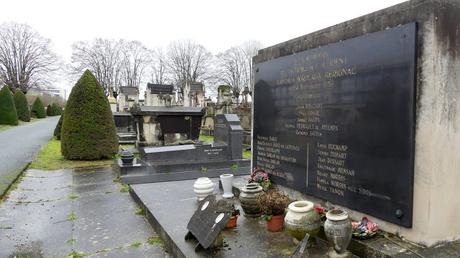
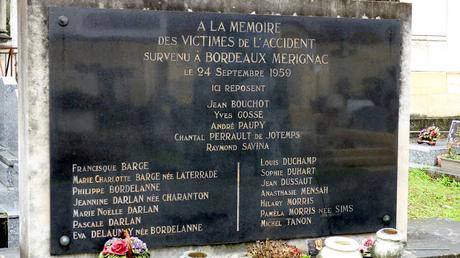
Sixty years on, this air disaster – the most deadly to have ever occurred in the area – seems to have faded into the mists of history, so hopefully this article will help keep the memory of the event alive, and possibly even raise awareness of that sad night in 1959 when a Transports Aériens Intercontinentaux DC-7C sadly failed to reach its destination.
> Find it on the Invisible Bordeaux map: TAI Flight 307 crash site, Boulac district, Saint-Jean d’Illac & TAI Flight 307 grave and memorial, Chartreuse cemetery, Bordeaux.
> The disaster has its own Wikipedia entry https://en.wikipedia.org/wiki/TAI_Flight_307
> Information for this article was also culled from aviation-safety.net and the official BEA report of the investigation into the accident.
> Picture of the F-BIAP Douglas DC-7C from http://aerobernie.bplaced.net/TAI.html which features many other picture postcards issued by former airlines.
> Ce dossier est également disponible en français.
